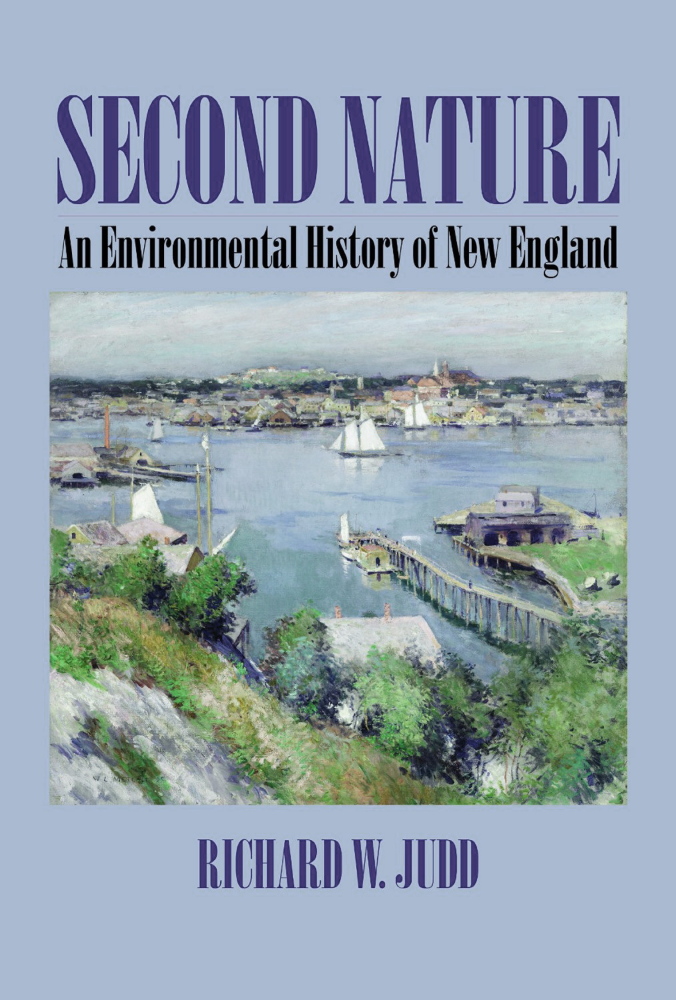Writing an environmental history of New England is a Sisyphean task; in fact, it’s several of them.
The region is hardly monolithic. Neither is “environmental history.” Is it a history of land use? Of natural resource exploitation? Of changes in the landscape? How does it mesh with the human events being played out across its mountains and plains, forests and fields, rivers and coast?
Even the word “environmental” – and its close cousin, “conservation” – is tricky, having implied different things over the centuries.
Richard Judd is certainly no stranger to these problems. “This book is an experiment,” he announces with his first sentence. Historically, his subject has been addressed from two points of view: either the environment determines the culture of those living in it or the culture of those living in it subdues and degrades the environment. “I resolved to combine these approaches by describing nature and culture not as antagonistic or even as dialectical, but essentially as an ecological whole: a bioregion.”
For better or for worse, New England has essentially nothing left of its “true first-nature wilderness.” Instead, it contains “several iconic second-nature landscapes, ranging from working woods to rolling farmland.” Hence the title of the book.
“Second Nature” begins with the arrival of humans following the retreat of the glaciers some 12,000 years ago. Although we complacently assume that the first 10,500 of those years were a period of little change, Judd demonstrates with considerable detail the different Native American cultures, how a warming climate changed the ecology and how indigenous customs reacted to these changes.
With the arrival of agriculture, “Gardens had to be defended against weeds and animals, which added a degree of tension in a society’s consciousness of the natural world,” Judd writes. “This tension probably crystallized village leadership and emphasized the arts of warfare, diplomacy, and ceremony; relations with other peoples became more important than relations with the natural world.”
Then the Europeans arrived. Judd, who is chairman of the history department at the University of Maine, takes the reader through the colonial period and then focuses on the “ecologies of frontier farming.”
At times, his narrative raises the question of where to draw the line between “regular” and environmental history. The Beaver Wars were “perhaps the most brutal in North American history,” but except for their range – Cape Breton to the Chesapeake to the Great Lakes – that’s all we learn. That is probably more than enough, given his topic, but it is tantalizing, to say the least, to one who never heard of them.
Judd grapples with another challenge: Beauty and/or evil are in the eye of the beholder. Farming in the new republic was seen as “harmonious adjustment” and the “only successfully blended … natural and man-made environment that America has ever known” by one generation of historians, but as environmental abuse by the next. Judd’s scrupulous inclusion of a wide range of points of view (there are 50 pages of notes) frequently leaves the reader reeling.
In the section covering the 19th century and the Industrial Age, he is particularly insightful on the Romantics, the artists and writers who paved the way for summer rusticators. And he has an interesting way of approaching the industrial landscape – the cities and mills – as “products of nature as well as constructions of culture.”
Finally, he leads us through the conservation efforts of the past more than 150 years. “Saving second nature,” he sums up, “was less dramatic than protecting the great earth monuments of the West, but it was a goal worth pursuing at a time when ‘first’ nature was shrinking at an alarming rate.… New England’s preservationist achievements remain, today more than ever, the region’s greatest gift to the American environmental legacy.”
There is a plethora of fascinating material in “Second Nature,” but its organization led to confusion, if not apparent contradictions.
Some of the author’s references to European history seem eccentric. European conquest, he writes, was framed by, among other things, “dispossession of indigenous peoples in Moorish Iberia.” The Moors were hardly indigenous. They had conquered the Iberian peninsula in the early 8th century, and the Spanish “Reconquista” started almost at once.
Although Judd does not wish to propose “a simple celebration of second-nature landscapes,” I suspect he would agree, as I do, with T.S. Eliot that “it is not necessarily those lands which are the most fertile or most favored in climate that seem to me the happiest, but those in which a long struggle of adaptation between man and his environment has brought out the best qualities of both.”
Thomas Urquhart is the author of “For the Beauty of the Earth” and “A Certain Persistence of Character: Land Conservation in Maine – 1900-2000.”
Send questions/comments to the editors.



Success. Please wait for the page to reload. If the page does not reload within 5 seconds, please refresh the page.
Enter your email and password to access comments.
Hi, to comment on stories you must . This profile is in addition to your subscription and website login.
Already have a commenting profile? .
Invalid username/password.
Please check your email to confirm and complete your registration.
Only subscribers are eligible to post comments. Please subscribe or login first for digital access. Here’s why.
Use the form below to reset your password. When you've submitted your account email, we will send an email with a reset code.